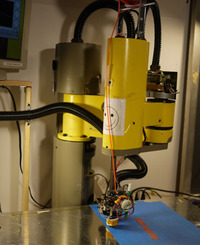 The folks at Hackaday found a 190 pound experimental 3D printer made from a scrap industrial robot arm – and it actually works. Made by Rensselaer Polytechnic Institute undergrad and maker extraordinary Dane Kouttron, this project required an enormous amount of effort to convert the surplus robot arm into a working 3D printer.
The folks at Hackaday found a 190 pound experimental 3D printer made from a scrap industrial robot arm – and it actually works. Made by Rensselaer Polytechnic Institute undergrad and maker extraordinary Dane Kouttron, this project required an enormous amount of effort to convert the surplus robot arm into a working 3D printer. The robot arm was “scavenged from a lab clean out” and “the motor drives, servo amplifiers and control hardware was nowhere to be found.” That’s where Kouttron started. Where he ended up was a completely functional 3D printer powered by a now-working industrial robot arm.
This particular approach is well beyond most people’s capabilities, as you’ll see if you read Kouttron’s very extensive description of the project, which includes software code and a mathematical model of the mechanical movements. According to Kouttron, the kinematics model is “A HECKUVA LOT MORE COMPLEX than cartesian systems used in a makerbot style 3dprinter.”
We’re wondering what this experiment tells us. Such an approach simplifies the build chamber of a 3D printer: there isn’t one! A robot arm could build on any suitable surface, although a heated surface would assist with warp prevention. Secondly, the size of printed models can be much larger than conventional 3D printers that are constrained by their movement rails. This unit is limited only by the arm’s “reach”.
Finally, we think that this approach, like any extrusion approach, is limited in that it is must laboriously trace out every portion of the model. This means prints will take considerable time, particularly if finer resolution is required.
Nevertheless, it’s a truly superhuman feat of engineering to make this work. And the happy face is totally necessary.
Via Hackaday and Transistor-Man

